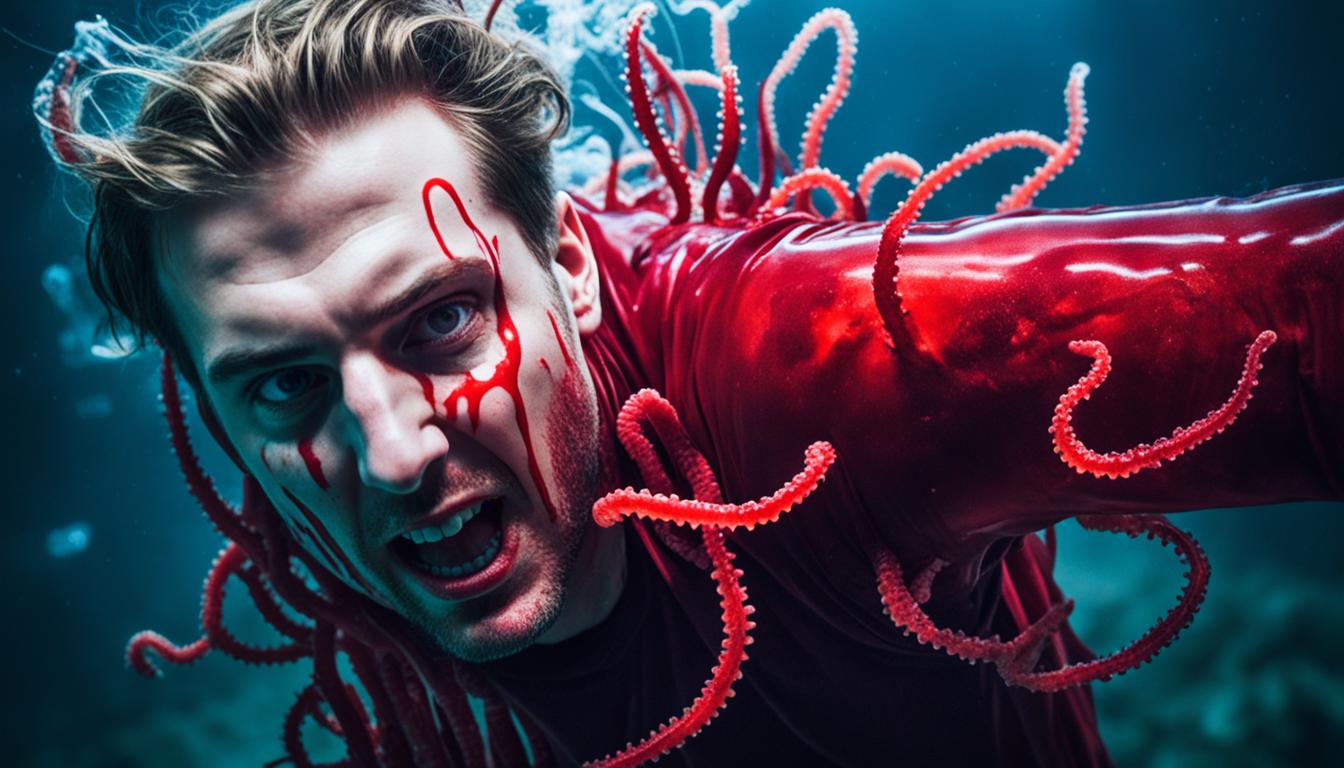Jellyfish stings are painful and sometimes dangerous. They happen when a jellyfish’s tentacles inject venom. You’ll feel pain, see redness, some swelling, and feel itchy where you were stung. More serious stings can cause hard breathing, cramps, sickness, and maybe even heart problems.
It’s important to help someone stung by a jellyfish right away. The first step is to remove any tentacles left on the skin. Then, you should try to reduce the pain. Recent treatments using stem cells show they might make recovery quicker. They could also help lessen the sting’s lasting effects.
Key Takeaways:
- Jellyfish stings can cause pain, redness, swelling, and itching.
- Severe cases of jellyfish stings can lead to difficulty breathing, muscle cramps, and even cardiovascular collapse.
- Immediate first aid is essential to remove tentacles and provide pain relief.
- Stem cell therapy has shown promise in accelerating healing and minimizing long-term effects of jellyfish stings.
Understanding Jellyfish Stings and Their Venom
Jellyfish stings can cause a lot of pain. It’s vital to know how these stings work. Jellyfish have venom in their tentacles, which they use to protect themselves.
These tentacles hold cells called nematocysts. Nematocysts inject venom when they touch something. This is how jellyfish sting people.
The venom in jellyfish varies by type. Some, like the box jellyfish and Portuguese man-of-war, are especially dangerous. Their venom can cause a lot of harm.
If stung by some jellyfish, the Irukandji syndrome can happen. It is very serious and can be life-threatening. Symptoms include severe pain, muscle cramps, and even heart problems.
Looking closely at jellyfish and their venom helps us understand stings better. This insight helps us deal with jellyfish more safely.
Advances in Diagnosis, Treatment, and Prevention
Jellyfish stings are diagnosed by looking at their symptoms. Knowing if someone has recently touched a jellyfish is helpful. If stung, it’s important to act fast. First, take out any tentacles without touching them with your hands. Use tweezers or a towel for this. It used to be said that vinegar was best for jellyfish stings. Now, studies show that putting the area under hot water or using ice is better for pain and stopping the venom from spreading.
For hot water treatment, use water that’s warm but not too hot. This can help to get rid of the jellyfish venom. It makes the pain go away fast. Another option is to use ice packs on the sting. Ice can lessen swelling and make the area numb, which makes it feel better for a while.
Stop jellyfish stings by wearing the right gear like stinger suits. This keeps jellyfish tentacles from touching your skin. Also, keep an eye out for jellyfish when in the water. Try to avoid spots where they’re known to be a lot.
Experts are always looking for new ways to treat and stop jellyfish stings. They’re looking into using stem cells. This might help heal stings faster and make the effects less severe over time. By using new ideas, we can stay safe from jellyfish bites.
FAQ
Q: What are the symptoms of a jellyfish sting?
A: Jellyfish stings bring pain, redness, swelling, and itching where you got stung. In bad cases, you might find it hard to breathe, have muscle cramps, feel sick, or your heart might suddenly not work right.
Q: How are jellyfish stings diagnosed?
A: To diagnose a jellyfish sting, doctors look at how you’re feeling and if you’ve recently been in contact with jellyfish.
Q: What is the recommended first aid treatment for jellyfish stings?
A: The first thing to do for a jellyfish sting is get rid of any tentacles left on your skin. Then, try to ease the pain. Using hot water or ice on the sting site can help a lot.
Q: Can vinegar be used to treat jellyfish stings?
A: Vinegar used to be a go-to for jellyfish stings, but now we know hot water or ice might be better. They help with the pain and stop the venom from spreading.
Q: How can jellyfish stings be prevented?
A: Wear things like stinger suits to protect yourself from jellyfish. Know where jellyfish live and be careful when swimming or doing water sports.
Q: What are the most dangerous jellyfish species?
A: The box jellyfish and the Portuguese man-of-war are very dangerous. Their venom can cause severe problems, even the deadly Irukandji syndrome.

